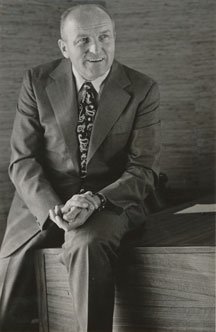
IRIS login | Reed College home Volume 92, No. 1: March 2013
In Memoriam
The Lion
John D. Gray
[trustee 1961–2006; emeritus trustee 2006–12] October 19, 2012, from cancer.
By Randall S. Barton

He was one of Oregon’s preeminent entrepreneurs, a decorated military hero, developer, and philanthropist who left an indelible mark on many charitable organizations—perhaps none so profoundly as Reed, which he helped to rescue from the brink of insolvency in the 1970s.
Gray was renowned for his business acumen, but those who knew him were also struck by his immense generosity.
“John Gray was such a huge figure in Oregon business and public life that it was pretty hard to be involved in politics, public policy, and the like without getting to know him,” says Stephen McCarthy ’66 [trustee 1988–2009], proprietor of Oregon’s Clear Creek Distillery. “He was everywhere, working on all kinds of good causes: libraries, music, schools. He was a visionary.”
Gray was born in 1919, the eldest of three sons of rancher Elmer Gray and his wife, Mabel, of Ontario, Oregon. Elmer died when John was in the first grade and the family moved to the small town of Monroe, between Corvallis and Eugene in the Willamette Valley. Mabel taught in a one-room, rural school and encouraged her boys to read, work hard, and be honest. The three Gray boys made money hauling hay, feeding pigs, and milking cows for neighboring farmers who became their surrogate fathers.
“When the smelt ran in the Sandy River each spring, a couple of neighbors would load a bathtub up in a truck, drive up to the mouth of the river, fill the tub with netted fish, and drive it back down the mountain to Monroe,” says Gray’s daughter, Joan. “Each family would gather around the truck and fill their crocks with alternating layers of salt and fish. So all through the winter the salted fish would be rinsed, soaked, and fried up for dinners.”
“We were poor and didn’t know it, and so was everybody else,” Gray recalled in an oral history recorded in 2007 by Michael O’Rourke ’66.
In 1936 Gray graduated from Monroe High School, where he had edited the school newspaper, and attended Oregon State College on a scholarship. He claimed to have chosen secretarial science as his major because during registration it had the shortest line. In any case, the discipline (which offered instruction in business, law, and accounting, in addition to secretarial skills) prepared him for his first job out of college as a cost accountant.
After the bombing of Pearl Harbor, Gray served five years in the U.S. Army’s 82nd Airborne Division, earning the rank of lieutenant colonel and a Bronze Star. Listening to soldiers talk about the businesses they’d run before the war, Gray decided to take advantage of the GI Bill and get an MBA when the war ended.
Before heading off to the Harvard School of Business, he married Elizabeth “Betty” Neuner, the daughter of Oregon’s attorney general. They’d met during his senior year at Oregon State and corresponded throughout the war. Together they formed a dynamic partnership, with Betty’s generosity and charm balancing John’s understated reserve.
After Boston, the Grays returned to Oregon and he was invited to join a fledgling company called Oregon Saw Chain, whose Cox Chipper Chain had revolutionized the industry by introducing lightweight, high-speed, direct-drive chain saws. The business was a rough-hewn start-up—Gray used an upturned nail keg for his first office chair—but thrived under his leadership. By the time he stepped down in 1985 as CEO of the company (renamed Omark Industries), it employed 4,000 people worldwide.
“There wasn’t an ounce of tycoon in John, even though he was the apotheosis of the successful Oregon businessman,” says Gerald Bidwell [trustee 1985–2006]. “He didn’t have any, what I would call, star power. There was no look at me feature about him that all of a sudden drew him into your field of view. I came to admire the style with which he did things and his understated way of dealing with people and issues. He was modest, but people found what he said compelling.”
Building the future
The process of building things fascinated Gray. In the ’60s, he combined his business acumen with an abiding respect for the natural landscape to build pioneering resorts that combined homesites, lodging, restaurants, golf courses, spas, and shops. He was partial to the functionality and clean simplicity of mid-century Scandinavian design, which integrated structure with nature. This aesthetic informed both Salishan, a project sited near Gleneden Beach between the Pacific Ocean and Siletz Bay, and Sunriver, a 5,000-acre resort community 15 miles south of Bend.
“He did not tolerate cleverness or artifice,” says designer Carol Edelman, who worked with Gray for years, beginning with the Water Tower at John’s Landing. “The natural world was his touchstone.”
“In each of his developments he went into areas where it hadn’t occurred to anyone else that there might be opportunity,” says Bidwell. “He was there early and substantially.”
An early proponent of land-use planning, Gray believed it was possible to plan for growth and build successful developments. His signature projects include the Irving Street Lofts in Portland and Skamania Lodge in Stevenson, Washington. He transformed a blighted, industrial area between Southwest Macadam Avenue and the Willamette River, known as John’s Landing, into a mixed-use community of offices, housing, and retail.
But even more lasting than his developments were his philanthropic endeavors, which always built on the future.
“No one will ever know the extent to which the Grays gave,” says Nancy Bragdon [presidential spouse 1971–88]. “Very often the publicity given to their giving was at the behest of the institution, which wanted not just the money but for people to know who gave it.”
The list of institutions, individuals, and causes that Gray supported is long and diverse: everything from affordable housing and promoting leadership among young Latinos to the Knight Cancer Institute at Oregon Health & Science University, Habitat for Humanity, and the Portland Japanese Garden.
“John came from a family where hard work was first and foremost,” says trustee Daniel Greenberg ’62. “He applied that kind of rigor and strength to the way in which he thought about and acted on ideas relating to philanthropy. Even though he was so successful as an entrepreneur, I think it was philanthropy and affection for their family which defined John and Betty.”
From a young age, Gray was taught that you did what you could, shared what you had, and took what you needed, says his daughter, Joan. Giving and getting were equal parts of life.
Laura Winter, vice president of the Oregon Community Foundation, worked with Gray for the last 23 years. She characterized him as an informed, committed, and determined philanthropist, who was always willing to take a risk on an unknown project or idea.
“John used philanthropy as a tool for mentoring and as a way to exercise his business expertise,” she says. “He liked to lead the charge to encourage others to give. Matching and challenge grants were a real sweet spot for him.”
Saving Reed
In the early ’60s, Richard Sullivan [president 1956–67] began inviting local entrepreneurs, including Gray, to serve on Reed’s board of trustees, in part to shore up the college’s precarious finances.
In those days the Portland business community tended to dismiss Reed as a hotbed of socialism, says Colin Diver [president 2002–12]. “But even at that time, or maybe especially at that time, it was also a place of extraordinary academic excellence, brilliance, and distinctiveness, and there’s no question that John saw that right away. The sheer fact that John Gray had adopted Reed College was enormously valuable to the college and gave it a kind of legitimacy that it really needed.”
If finances looked gloomy in the ’60s, they were downright dismal by 1971 when Paul Bragdon became president. By the time internal institutional loans were charged off, the endowment had dwindled to $4 million, and years of threadbare budgets were beginning to bite.
“The college had some bank debt and other problems that were threatening its future,” says Bidwell. “Howard Vollum ’36 [trustee 1955–79] and John Gray were instrumental in gathering together folks who shared a view that Reed had a purpose and a future.”
When Daniel Greenberg ’62 joined the board of trustees in 1975, he was “stunned” at how difficult the college’s financial circumstances had become.
“Howard Vollum and John Gray kept Reed solvent and healthy during a time it was near to going under,” he says. “Working in tandem, they put Reed on firmer footing and allowed Paul to carry out his mandate. They made it their mission to help the school survive and prosper.”
Together with Richard Wollenberg [trustee 1962–2005], Ed Cooley [trustee 1968–2000], and Walter Mintz ’50 [trustee 1971–2004], Gray again rode to the rescue in the ’80s and early ’90s when private liberal arts colleges were being threatened by special colleges built by state universities.
“These special colleges looked and smelled like us,” says Steven Koblik [president 1992–2001], “but were publicly funded. John believed it was extraordinarily important for the Pacific Northwest, Oregon, and Portland to have an institution of Reed’s quality. He was a board member that any institution in the country would have killed to have.”
In addition being a good judge of people and what you could expect from them, Gray was wise about the way organizations function, with the capacity for helping others to see the totality of the enterprise.
Gray stepped down from the board in 2006, having served Reed for 45 years. From 1967 to 1982 he served as chair of the board; he also chaired the college’s first comprehensive fundraising campaign, completed in 1988, which raised $60 million. Over the years, he and Betty gave more than $25 million to the college, designating a wide variety of uses including environmental studies, financial aid, canyon restoration, the Annual Fund, and, of course, the Gray Fund.
“John had an absolute integrity, steadiness, and a kind of wisdom about just everything that’s important in the governance of an institution,” Diver says. “He endorsed Reed because he saw it as a civic treasure that had to be supported, because he cared about civic treasures and he cared about building public goodness. John supported so many institutions and he didn’t just hand them a pile of cash. He really made a difference.”
On December 2, a memorial tribute was held at Kaul Auditorium, hosted by the college and Gray’s four living children, Jack Gray, Joan Gray, Janet Webster, and Laurie Gearhart. Many grandchildren and great-grandchildren also succeed John. His daughter Anne Walrod ’71 died in 1994 and his wife, Betty, in 2003.
During the memorial Tony Arnerich, Gray’s financial adviser, said, “His mandate to me was simple: ‘Grow our assets so we can give more away.’ And boy, did he give it away.”


LATEST COMMENTS
steve-jobs-1976 I knew Steve Jobs when he was on the second floor of Quincy. (Fall...
Utnapishtim - 2 weeks ago
Prof. Mason Drukman [political science 1964–70] This is gold, pure gold. God bless, Prof. Drukman.
puredog - 1 month ago
virginia-davis-1965 Such a good friend & compatriot in the day of Satyricon...
czarchasm - 4 months ago
John Peara Baba 1990 John died of a broken heart from losing his mom and then his...
kodachrome - 7 months ago
Carol Sawyer 1962 Who wrote this obit? I'm writing something about Carol Sawyer...
MsLaurie Pepper - 8 months ago
William W. Wissman MAT 1969 ...and THREE sisters. Sabra, the oldest, Mary, the middle, and...
riclf - 10 months ago